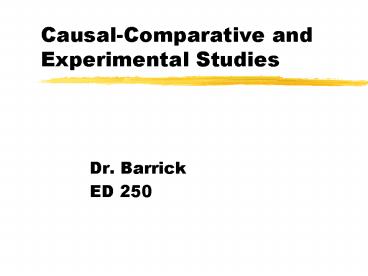CausalComparative and Experimental Studies - PowerPoint PPT Presentation
1 / 28
Title:
CausalComparative and Experimental Studies
Description:
Ex Post Facto Study: Study after the fact. ... Improved scores on a post-test as a result of taking the pre-test. ... Forms of pre-test and post-test are not the same. ... – PowerPoint PPT presentation
Number of Views:88
Avg rating:3.0/5.0
Title: CausalComparative and Experimental Studies
1
Causal-Comparative andExperimental Studies
- Dr. Barrick
- ED 250
2
Definition of Causal-Comparative
- Research that attempts to determine the cause or
reason for pre-existing differences in groups or
individuals - Ex Post Facto Study Study after the fact.
- ExampleHaving your father/mother tutor in math
at home may be a factor in higher achievement.
3
Purpose of Causal-Comparative Research
- Attempts to identify a cause-effect relationship
between variables correlational studies do not. - Causal-Comparative research involves comparison
not relationship. - Individual students are not randomly assigned as
in experimental studies. - There is no treatment as experimental studies.
4
Examples of Independent Variables in
Causal-Comparative Studies
- Orgasmic Variables
- Age
- Sex
- Ethnicity
- Ability Variables
- Intelligence
- Scholastic Aptitude
- Specific Aptitude
- Perceptual Aptitude
5
More Variables
- Personality
- Anxiety
- Introversion
- Aggression
- Self-concept
- Self-esteem
- Aspiration
- Learning styles
- Family
- Income
- SES status
- Employment status
- Marital status
- Environment
- Birth order
- Number of siblings
6
More Variables
- School
- Preschool attendance
- Size of school
- Type of school
- Per pupil expenditure
- Type of curriculum
- Leadership style
- Teaching style
- Peer pressure
7
Notes
- Definition and selection of comparison groups is
very important. Selection bias is a danger. - Lack of randomization, manipulation, and control
are all sources of weakness. - There may be another variable which is the real
cause of the observed difference between groups.
8
Ways to control
- Matching
- Homogeneous groups
- Analysis of covariance
9
Experimental Studies
- Dr. Stan Barrick
- ED 250
- Educational Research
10
Definition of Experimental
- In an experimental study, the researcher
manipulates at least one independent variable,
controls other relevant variables, and observes
the effect on one or more of the dependent
variables. - Independent variable is called the experimental
variable.
11
Steps in Experimental Study
- Selection and definition of the problem.
- Selection of the sample.
- Selection of the instruments.
- Selection of design.
- Execution of procedures.
- Analysis of data.
- Formulation of conclusions.
12
Properties of Experimental Studies
- Has at least one hypothesis that states an
expected causal relationship between two
treatment variables. - Randomly selects the samples for the two or more
treatments. - Controls for external variables.
- Has a control group and manipulates a variable.
- Looks for significant differences due to the
treatment.
13
Experimental Validity
- Any uncontrolled extraneous variables that
affect performance on the dependent variable are
threats to the validity of an experiment. - Internal validity ensuring that the observed
differences of the dependent variable are due to
the independent variable. - External validity ensuring that the results are
generalizable.
14
Threats to Internal Validity
- History
- Maturation
- Testing
- Instrumentation
- Statistical regression
- Differential selection of sample
- Mortality
- Selection-maturation interaction.
15
History
- The occurrence of events that affect the outcome
but are not part of the design. - The longer the experiment lasts the more likely
that history will interfere.
16
Maturation
- The natural physical, intellectual, and emotional
changes that occur in the participants over a
period of time and which affect the dependent
variable. - Most likely to be a threat during the
developmental stages of growth.
17
Testing
- Improved scores on a post-test as a result of
taking the pre-test. - Usually a threat when factual information is to
be recalled.
18
Instrumentation
- The lack of reliability and consistency in the
measuring instruments. - Forms of pre-test and post-test are not the same.
- Observations are not normed between observers.
- Mechanical devices which collect data are not
reliable.
19
Statistical Regression
- Statistical regression occurs when a participant
scores extremely high or low. On successive
score will tend toward the mean. - Can occur when testing gifted or LH students on a
standardized test.
20
Differential Selection
- Usually occurs when preformed groups are
compared. - Example- comparing the students at a community
college with the students at a university.
21
Mortality
- Attrition of participants affects the study.
- Example- the study of a teaching method with one
group having a high mobility rate.
22
Selection Interactions
- Selection interacts with maturation.
- Selection interacts with history.
- Selection interacts with instrumentation.
- Etc.
23
Threats to External Validity
- Pre-test treatment interaction.
- Selection treatment interaction.
- Multiple treatment interaction.
- Specificity of variables.
- Treatment diffusion.
- Experimenter effect. Pygmilan Effect
- Reactive effect. Hawthorne Effect
24
Pre-Experimental Designs
- One shot case X O
- One group pre/post-test 0 X O
- Static group comparison
25
Experimental Designs
- Pre/Post test control group
- Post test only control group
26
Experimental Designs
- Solomon four group design
27
Quasi-Experimental Designs
- Non-equivalent control group
- Time Series
28
Quasi-Experimental
- Counterbalanced































